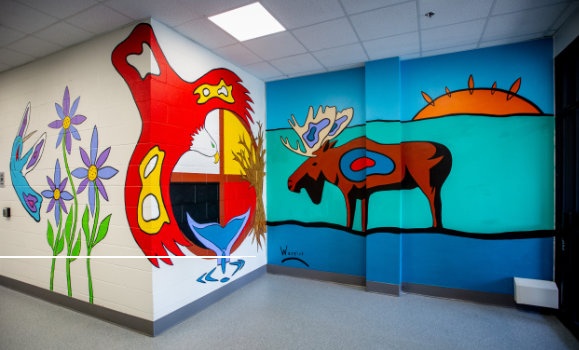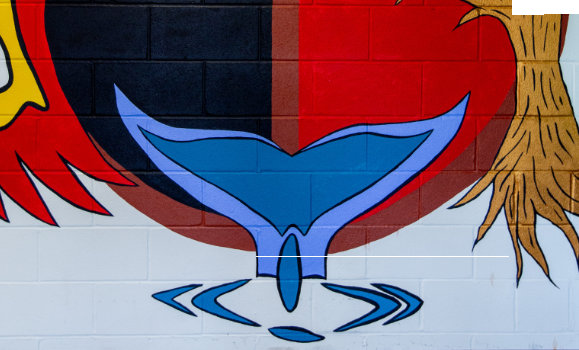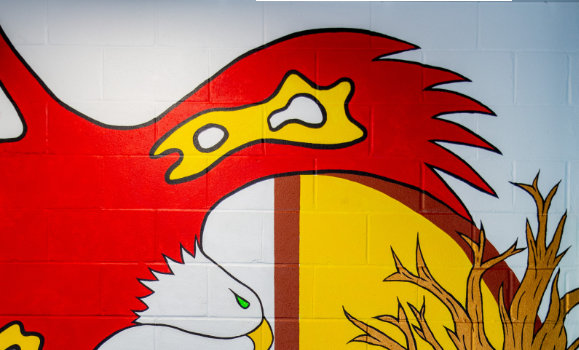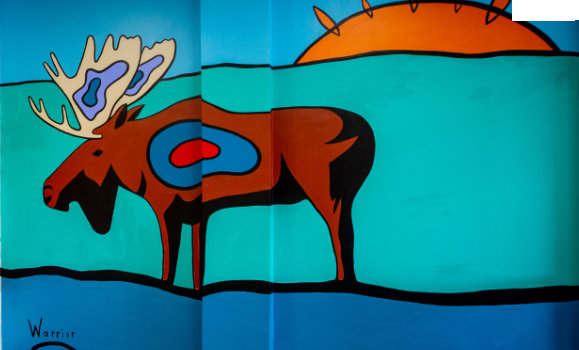News
» Go to news mainWarrior on the Hill

Lorne Alexander Julien is a proud MiвҖҷkmaw artist and member of Millbrook First Nation, Nova Scotia. He recently completed two murals on the Agricultural Campus in Cox Institute вҖ“ one in the new Indigenous Student Space in East Cox and most recently one in the entrance of West Cox.
Julien is a self-taught artist specializing in rich vibrant colours. He creates murals in schools, institutions, and public spaces to Indigenize and create safe spaces that are inclusive, respectful and honour CanadaвҖҷs Indigenous People. He believes incorporating Indigenous art in public spaces is a simple act of reconciliation and moving forward in a spirit of mutual respect and understanding.
вҖңThe painting reminds us to honour the cycles and respect all the elements when we work with the land,вҖқ explained Julien.
вҖңThe centre of the mural shows the medicine wheel, representing the four colours, the four seasons, the four directions. There are many teachings in the medicine wheel,вҖқ said Julien.В вҖңIt can also represent the circle of life.вҖқ
 вҖңThe whale (putup) represents water and all the water cycles and the life that depends on the water. The tree is connected to the earth and the air.В We breath in what the trees breathe out and vice versa, that is how we survive,вҖқ he added.
вҖңThe whale (putup) represents water and all the water cycles and the life that depends on the water. The tree is connected to the earth and the air.В We breath in what the trees breathe out and vice versa, that is how we survive,вҖқ he added.
 вҖңThe eagle (kitpu) is an important element in my paintings, they are protectors and represent love. The hummingbird (militaw) symbolizes beauty, joy, and playfulness.В The moose spirit (tiam) coming into the mural from the side is a woodland creature, tiam stands for protecting habitats and the need to share the earth in a good and respectful way.вҖқ
вҖңThe eagle (kitpu) is an important element in my paintings, they are protectors and represent love. The hummingbird (militaw) symbolizes beauty, joy, and playfulness.В The moose spirit (tiam) coming into the mural from the side is a woodland creature, tiam stands for protecting habitats and the need to share the earth in a good and respectful way.вҖқ
 LorneвҖҷs MiвҖҷkmaw name is вҖҳWarrior on the HillвҖҷ (Sma'knis) which was given to him in his youth when he learned about the spiritual way of his people. His artwork is a form of prayer, providing healing for himself and to the world. His intention is to inspire hope and balance within the universe.В
LorneвҖҷs MiвҖҷkmaw name is вҖҳWarrior on the HillвҖҷ (Sma'knis) which was given to him in his youth when he learned about the spiritual way of his people. His artwork is a form of prayer, providing healing for himself and to the world. His intention is to inspire hope and balance within the universe.В
These two murals are a small step in a much bigger plan to help Indigenize the Agricultural Campus to be a welcoming and inclusive space for all learners and one in which indigenous students can see their community honoured and reflected.
вҖңThe Indigenous Student Space in East Cox is always being used by students and their allies, often for the meeting of the Indigenous Student Collective and a place to host Indigenous eventsвҖқ explained Keah Gloade, manager of Indigenous students.
One of the features students take great pride in, is the mural in this space.
вҖңIt has important meaning with colours reflecting residential schools, animal symbolism for the concept of love and family as well as representing the four pillars of the medicine wheel,вҖқ she added.В вҖңIвҖҷm so proud to have such a meaningful space on campus feel complete with the addition of the mural for our Indigenous students. IвҖҷm excited for the students to return in September and see the addition of our newest mural in West Cox, they will feel valued and appreciated in their Indigeneity on campus- which is reconciliation in action.вҖқ
Keah works to help foster Aboriginal student success by providing specialized advising and support. Additionally, she serves to assist faculty and staff to create a welcoming and inclusive campus environment.
This includes working to Indigenize the curriculum of several first-year courses as well as select second year courses.В The Faculty of Agriculture is also developing a series of co-curricular activities on campus with an aim of increasing Indigenous cultural awareness and inclusivity. В
The incorporation of Indigenous perspectives and ways of knowing in curriculum, policy and on campus landscapes will ensure administrators, faculty and staff have a broader understanding of Aboriginal culture, values, traditions, and customs.
The Indigenous Student space also provides a second space for smudging.
вҖңIt makes our room so inviting, its nice to have visual representation of our values,вҖқ said Kylie Harquail Simonson, President of the Indigenous Student Collective. вҖңNo matter where we are, we are connected.вҖқ
The Indigenous Student Access Pathway (ISAP) has also been designed and delivered as a one-year program exclusively for First Nations, Metis and Inuit students who would not otherwise be eligible for admissions and who would benefit from dedicated supports while transitioning to a university environment.
Throughout the student experience there will be opportunities for community involvement, access to РВјУЖВБщәПІКҝӘҪұЦұІҘвҖҷs Elders in Residence program and more.В By immersing students in a strong and supportive network of faculty, staff, and peers the ISAP aims to provide both the tools for navigating post-secondary and a culturally supportive environment needed to succeed.
The Agricultural Campus is also uniquely situation among 13 First Nations communities and in 2016 permanently installed the MiвҖҷkmaq Grand Council Flag- a first for a Nova Scotia university - acknowledging the campus sits on Traditional Territory of the indigenous MiвҖҷkmaq people
вҖңOur campus is a place of learning for everyone, no matter their background, culture, gender or sexual orientation,вҖқ said Dean David Gray.В вҖңIt is crucially important that members of our indigenous communities see themselves here as part of our community and feel welcomed. It is also important, as a place of learning, that we embrace the knowledge of our indigenous elders and share with all.вҖқ
For those who have a vested interest in a university experience and in particular a science experience, are also offered an opportunity to spend a weekend on the Agricultural Campus.
Awtiket Summer Camps, meaning вҖҳclearing a pathвҖҷ are offered to Indigenous students aged 12 вҖ“ 16 years of age over a weekend to immerse them in university life.В Students attend classes, stay in residence and experience extra-curricular activities.
Recent News
- MacRae Library Student Research poster competition
- Senator Colin Deacon recognizes Jolene MacEachern with King Charles III Coronation Medal
- AC graduates driving innovation and growth in the Dairy Industry with Lely North America
- Homecoming 2024 Photo Recap
- Hall of Fame inducts four new members
- 2024 Blue & Gold Awards presented
- Honouring Indigenous Knowledge: Community Food Systems in the Philippines
- Food Services Reading Week Hours вҖ‘ November 11 вҖ‘ 15, 2024.
